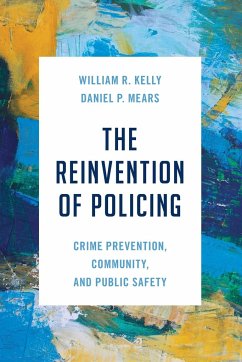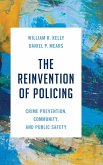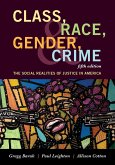William R. Kelly, Daniel P. Mears
The Reinvention of Policing
Crime Prevention, Community, and Public Safety
William R. Kelly, Daniel P. Mears
The Reinvention of Policing
Crime Prevention, Community, and Public Safety
- Broschiertes Buch
- Merkliste
- Auf die Merkliste
- Bewerten Bewerten
- Teilen
- Produkt teilen
- Produkterinnerung
- Produkterinnerung
Written in an accessible style, this book provides a historically grounded critique of American policing and offers implementable solutions, providing students a comprehensive understanding of modern policing. The Reinvention of Policing can be used in courses focused on policing policy and practice, specifically when discussing how policing may reflect and contribute to inequality and injustice, or how it might improve these social problems.
Andere Kunden interessierten sich auch für
![The Reinvention of Policing The Reinvention of Policing]() William R. KellyThe Reinvention of Policing105,99 €
William R. KellyThe Reinvention of Policing105,99 €![Community and the Problem of Crime Community and the Problem of Crime]() Karen EvansCommunity and the Problem of Crime206,99 €
Karen EvansCommunity and the Problem of Crime206,99 €![Community and the Problem of Crime Community and the Problem of Crime]() Karen EvansCommunity and the Problem of Crime195,99 €
Karen EvansCommunity and the Problem of Crime195,99 €![Community and the Problem of Crime Community and the Problem of Crime]() Karen EvansCommunity and the Problem of Crime87,99 €
Karen EvansCommunity and the Problem of Crime87,99 €![Class, Race, Gender, and Crime Class, Race, Gender, and Crime]() Gregg BarakClass, Race, Gender, and Crime80,99 €
Gregg BarakClass, Race, Gender, and Crime80,99 €![Criminal Justice, Risk and the Revolt against Uncertainty Criminal Justice, Risk and the Revolt against Uncertainty]() Criminal Justice, Risk and the Revolt against Uncertainty75,99 €
Criminal Justice, Risk and the Revolt against Uncertainty75,99 €![The Palgrave Handbook of Australian and New Zealand Criminology, Crime and Justice The Palgrave Handbook of Australian and New Zealand Criminology, Crime and Justice]() The Palgrave Handbook of Australian and New Zealand Criminology, Crime and Justice224,99 €
The Palgrave Handbook of Australian and New Zealand Criminology, Crime and Justice224,99 €-
-
-
Written in an accessible style, this book provides a historically grounded critique of American policing and offers implementable solutions, providing students a comprehensive understanding of modern policing. The Reinvention of Policing can be used in courses focused on policing policy and practice, specifically when discussing how policing may reflect and contribute to inequality and injustice, or how it might improve these social problems.
Hinweis: Dieser Artikel kann nur an eine deutsche Lieferadresse ausgeliefert werden.
Hinweis: Dieser Artikel kann nur an eine deutsche Lieferadresse ausgeliefert werden.
Produktdetails
- Produktdetails
- Verlag: Rowman & Littlefield Publishers
- Seitenzahl: 300
- Erscheinungstermin: 19. Juni 2023
- Englisch
- Abmessung: 229mm x 152mm x 18mm
- Gewicht: 490g
- ISBN-13: 9781538179208
- ISBN-10: 1538179202
- Artikelnr.: 67657349
- Herstellerkennzeichnung
- Libri GmbH
- Europaallee 1
- 36244 Bad Hersfeld
- gpsr@libri.de
- Verlag: Rowman & Littlefield Publishers
- Seitenzahl: 300
- Erscheinungstermin: 19. Juni 2023
- Englisch
- Abmessung: 229mm x 152mm x 18mm
- Gewicht: 490g
- ISBN-13: 9781538179208
- ISBN-10: 1538179202
- Artikelnr.: 67657349
- Herstellerkennzeichnung
- Libri GmbH
- Europaallee 1
- 36244 Bad Hersfeld
- gpsr@libri.de
By William R. Kelly and Daniel P. Mears - Contributions by Madalena Almanza
Acknowledgements
About the Authors
Preface
1. Our Broken Criminal Justice System and the Failure to Put Public Safety
First
The Costly Failure of American Criminal Justice
Fundamentally Misunderstanding Public Safety
Why Focus on Policing?
Improving Policing and Public Safety
Structure of this Book
2. American Policing: A Litany of Problems
Introduction
Critical Problems in Policing-Design Flaws
Problem 1: Society Thinks that They Have a Crime Prevention Agency-They Do
Not
Problem 2: The Police Do Little to Address Known Causes of Offending or
Crime
Problem 3: Goals and Mission Creep
Problem 4: Lack of Clarity about How Large Police Departments Should Be
Problem 5: Increasingly Militarized Police
Problem 6: Lack of Coordination with Courts and Resistance to Reform
Critical Problems in Policing-Harmful Impacts
Problem 7: Failure to Prevent or Reduce Crime
Problem 8: Use of Force: Problems, Effectiveness, and the Ridiculous
Problem 9: Racism, Ethnic Bias, and Profiling
Problem 10: Police Accountability, Citizen Oversight, and Qualified
Immunity
Critical Problems in Policing-Operational Issues
Problem 11: Inadequate Officer Training
Problem 12: Police Discretion and Officer Supervision
Problem 13: The 911 System
Problem 14: Police Use of Time
Problem 15: Police Ill-Equipped to Manage the Consequences of Mass Reentry
Problem 16: Police Officers' Attitudes about Their Jobs
Problem 17: Public Attitudes about Policing
Critical Problems in Policing-Lack of Research, Monitoring, and Oversight
Problem 18: Little Systematic Reliance on Research
Problem 19: Accountability and the "Black Box" of Policing
Conclusion
3. How We Got Here: Policing that Does Not Prioritize Public Safety
(Co-authored with Madalena Almanza)
Introduction
Historical Origins of Policing
What Contributed to Expansion of Policing as a Reactive, Control-Oriented
Institution
Crime
Civil Disorder and the Johnson Presidency
Tough on Crime
The 1994 Crime Bill
The War on Drugs
Mission Creep: Dumping More and More Responsibilities on Police
911 and Reactive Policing
Broken Windows
The Warrior Cop
Conclusion
4. A Clean Slate: What Would an Effective Public Safety Approach Look Like?
Introduction
Establish Clear Goals: Crime Prevention and Public Safety
Identify and Monitor the Level and Distribution of Recidivism and Crime
Identify and Monitor the Causes of Recidivism and Crime
Use Evidence-Based Strategies to Prevent Offending and Reduce Recidivism
(Individuals)
Address Known Causes of Offending and Recidivism
Focus on Three Levels of Prevention
Rely on a Comprehensive Approach
Use Evidence-Based Strategies to Prevent and Reduce Crime (Communities)
Address Known Causes of Crime
Focus on Three Levels of Prevention
Rely on a Comprehensive Approach
Coordinate All Efforts
Rely on Continuous Research and Assessment
Assess and Improve Policy Design
Assess and Improve Policy Implementation
Assess Policy Impact and Cost-Efficiency
Assess Citizen Views and Experiences
Conclusion
5. Reforming Traditional Policing-Eliminating What Doesn't Work and Keeping
and Improving What Does Work to Promote Crime Prevention and Public Safety
Introduction
Improve Traditional Policing-What to Eliminate
Random, Preventive Patrol, Especially in Large Geographic Areas
Traffic Enforcement
Aggressive Policing, Zero Tolerance Policing, and Broken Windows Policing
Mental Health Calls
Police in Schools
Predictive Policing
Improve Traditional Policing-What the Police Should Do, Do More, and Do
Better
911 Reform
Hot Spots Policing
Problem-Oriented Policing
Community Policing
Proactive Policing
Police Recruiting and Training
Police Culture: Transitioning from Warrior to Guardian
Conclusion
6. Reinventing Policing within a System that Prioritizes Crime Prevention
and Public Safety
Introduction
Contemporary and Proposed Police Reforms
Reinventing American Policing to Accomplish Public Safety
Defining Crime Prevention
The Case for Crime Prevention
Crime Prevention Strategies by Law Enforcement in the U.S.
Crime Prevention Strategies by Law Enforcement in Other Countries
A New Model for American Policing
1. A Lead Agency Charged with Promoting Public Safety
2. Research Guidance on Crime and Its Causes
3. Multi-Agency Policing
4. Addressing Crime through Police Specialization and Improved Training
5. Crime Prevention through Collective Efficacy and Informal Social Control
6. Crime Prevention through Alternatives to the Police
7. Crime Prevention through a Systematic Approach
8. Crime Prevention through Improvement of 911 Call Systems
9. Leverage Public Support for Reinventing and Evaluating Policing
10. Research Evaluation of Implementation, Effectiveness, and
Cost-Efficiency
What Has to Happen for the Reinvention of Policing to Be Successful
Address Barriers to Reinventing Policing
Create Incentives for Reinventing Policing
Reality: Pragmatic Considerations and Reinvention of American Policing
Conclusion
7. Better Policing and Public Safety Means More Justice
Introduction
What Is Justice?
What Do Police Reforms and the Reinvention of Policing Mean for Justice?
Conclusion
8. Conclusion: Public Safety First
Introduction
A Litany of Problems (Key Points from Chapter 2)
Why Policing Is Broken and Needs to Be Reinvented (Key Points from Chapter
3)
A Clean-Slate View of How to Improve Public Safety (Key Points from Chapter
4)
Reforming Policing (Key Points from Chapter 5)
Reinventing Policing (Key Points from Chapter 6)
Improved Public Safety Means More Justice (Key Points from Chapter 7)
Conclusion
Bibliography
About the Authors
Preface
1. Our Broken Criminal Justice System and the Failure to Put Public Safety
First
The Costly Failure of American Criminal Justice
Fundamentally Misunderstanding Public Safety
Why Focus on Policing?
Improving Policing and Public Safety
Structure of this Book
2. American Policing: A Litany of Problems
Introduction
Critical Problems in Policing-Design Flaws
Problem 1: Society Thinks that They Have a Crime Prevention Agency-They Do
Not
Problem 2: The Police Do Little to Address Known Causes of Offending or
Crime
Problem 3: Goals and Mission Creep
Problem 4: Lack of Clarity about How Large Police Departments Should Be
Problem 5: Increasingly Militarized Police
Problem 6: Lack of Coordination with Courts and Resistance to Reform
Critical Problems in Policing-Harmful Impacts
Problem 7: Failure to Prevent or Reduce Crime
Problem 8: Use of Force: Problems, Effectiveness, and the Ridiculous
Problem 9: Racism, Ethnic Bias, and Profiling
Problem 10: Police Accountability, Citizen Oversight, and Qualified
Immunity
Critical Problems in Policing-Operational Issues
Problem 11: Inadequate Officer Training
Problem 12: Police Discretion and Officer Supervision
Problem 13: The 911 System
Problem 14: Police Use of Time
Problem 15: Police Ill-Equipped to Manage the Consequences of Mass Reentry
Problem 16: Police Officers' Attitudes about Their Jobs
Problem 17: Public Attitudes about Policing
Critical Problems in Policing-Lack of Research, Monitoring, and Oversight
Problem 18: Little Systematic Reliance on Research
Problem 19: Accountability and the "Black Box" of Policing
Conclusion
3. How We Got Here: Policing that Does Not Prioritize Public Safety
(Co-authored with Madalena Almanza)
Introduction
Historical Origins of Policing
What Contributed to Expansion of Policing as a Reactive, Control-Oriented
Institution
Crime
Civil Disorder and the Johnson Presidency
Tough on Crime
The 1994 Crime Bill
The War on Drugs
Mission Creep: Dumping More and More Responsibilities on Police
911 and Reactive Policing
Broken Windows
The Warrior Cop
Conclusion
4. A Clean Slate: What Would an Effective Public Safety Approach Look Like?
Introduction
Establish Clear Goals: Crime Prevention and Public Safety
Identify and Monitor the Level and Distribution of Recidivism and Crime
Identify and Monitor the Causes of Recidivism and Crime
Use Evidence-Based Strategies to Prevent Offending and Reduce Recidivism
(Individuals)
Address Known Causes of Offending and Recidivism
Focus on Three Levels of Prevention
Rely on a Comprehensive Approach
Use Evidence-Based Strategies to Prevent and Reduce Crime (Communities)
Address Known Causes of Crime
Focus on Three Levels of Prevention
Rely on a Comprehensive Approach
Coordinate All Efforts
Rely on Continuous Research and Assessment
Assess and Improve Policy Design
Assess and Improve Policy Implementation
Assess Policy Impact and Cost-Efficiency
Assess Citizen Views and Experiences
Conclusion
5. Reforming Traditional Policing-Eliminating What Doesn't Work and Keeping
and Improving What Does Work to Promote Crime Prevention and Public Safety
Introduction
Improve Traditional Policing-What to Eliminate
Random, Preventive Patrol, Especially in Large Geographic Areas
Traffic Enforcement
Aggressive Policing, Zero Tolerance Policing, and Broken Windows Policing
Mental Health Calls
Police in Schools
Predictive Policing
Improve Traditional Policing-What the Police Should Do, Do More, and Do
Better
911 Reform
Hot Spots Policing
Problem-Oriented Policing
Community Policing
Proactive Policing
Police Recruiting and Training
Police Culture: Transitioning from Warrior to Guardian
Conclusion
6. Reinventing Policing within a System that Prioritizes Crime Prevention
and Public Safety
Introduction
Contemporary and Proposed Police Reforms
Reinventing American Policing to Accomplish Public Safety
Defining Crime Prevention
The Case for Crime Prevention
Crime Prevention Strategies by Law Enforcement in the U.S.
Crime Prevention Strategies by Law Enforcement in Other Countries
A New Model for American Policing
1. A Lead Agency Charged with Promoting Public Safety
2. Research Guidance on Crime and Its Causes
3. Multi-Agency Policing
4. Addressing Crime through Police Specialization and Improved Training
5. Crime Prevention through Collective Efficacy and Informal Social Control
6. Crime Prevention through Alternatives to the Police
7. Crime Prevention through a Systematic Approach
8. Crime Prevention through Improvement of 911 Call Systems
9. Leverage Public Support for Reinventing and Evaluating Policing
10. Research Evaluation of Implementation, Effectiveness, and
Cost-Efficiency
What Has to Happen for the Reinvention of Policing to Be Successful
Address Barriers to Reinventing Policing
Create Incentives for Reinventing Policing
Reality: Pragmatic Considerations and Reinvention of American Policing
Conclusion
7. Better Policing and Public Safety Means More Justice
Introduction
What Is Justice?
What Do Police Reforms and the Reinvention of Policing Mean for Justice?
Conclusion
8. Conclusion: Public Safety First
Introduction
A Litany of Problems (Key Points from Chapter 2)
Why Policing Is Broken and Needs to Be Reinvented (Key Points from Chapter
3)
A Clean-Slate View of How to Improve Public Safety (Key Points from Chapter
4)
Reforming Policing (Key Points from Chapter 5)
Reinventing Policing (Key Points from Chapter 6)
Improved Public Safety Means More Justice (Key Points from Chapter 7)
Conclusion
Bibliography
Acknowledgements
About the Authors
Preface
1. Our Broken Criminal Justice System and the Failure to Put Public Safety
First
The Costly Failure of American Criminal Justice
Fundamentally Misunderstanding Public Safety
Why Focus on Policing?
Improving Policing and Public Safety
Structure of this Book
2. American Policing: A Litany of Problems
Introduction
Critical Problems in Policing-Design Flaws
Problem 1: Society Thinks that They Have a Crime Prevention Agency-They Do
Not
Problem 2: The Police Do Little to Address Known Causes of Offending or
Crime
Problem 3: Goals and Mission Creep
Problem 4: Lack of Clarity about How Large Police Departments Should Be
Problem 5: Increasingly Militarized Police
Problem 6: Lack of Coordination with Courts and Resistance to Reform
Critical Problems in Policing-Harmful Impacts
Problem 7: Failure to Prevent or Reduce Crime
Problem 8: Use of Force: Problems, Effectiveness, and the Ridiculous
Problem 9: Racism, Ethnic Bias, and Profiling
Problem 10: Police Accountability, Citizen Oversight, and Qualified
Immunity
Critical Problems in Policing-Operational Issues
Problem 11: Inadequate Officer Training
Problem 12: Police Discretion and Officer Supervision
Problem 13: The 911 System
Problem 14: Police Use of Time
Problem 15: Police Ill-Equipped to Manage the Consequences of Mass Reentry
Problem 16: Police Officers' Attitudes about Their Jobs
Problem 17: Public Attitudes about Policing
Critical Problems in Policing-Lack of Research, Monitoring, and Oversight
Problem 18: Little Systematic Reliance on Research
Problem 19: Accountability and the "Black Box" of Policing
Conclusion
3. How We Got Here: Policing that Does Not Prioritize Public Safety
(Co-authored with Madalena Almanza)
Introduction
Historical Origins of Policing
What Contributed to Expansion of Policing as a Reactive, Control-Oriented
Institution
Crime
Civil Disorder and the Johnson Presidency
Tough on Crime
The 1994 Crime Bill
The War on Drugs
Mission Creep: Dumping More and More Responsibilities on Police
911 and Reactive Policing
Broken Windows
The Warrior Cop
Conclusion
4. A Clean Slate: What Would an Effective Public Safety Approach Look Like?
Introduction
Establish Clear Goals: Crime Prevention and Public Safety
Identify and Monitor the Level and Distribution of Recidivism and Crime
Identify and Monitor the Causes of Recidivism and Crime
Use Evidence-Based Strategies to Prevent Offending and Reduce Recidivism
(Individuals)
Address Known Causes of Offending and Recidivism
Focus on Three Levels of Prevention
Rely on a Comprehensive Approach
Use Evidence-Based Strategies to Prevent and Reduce Crime (Communities)
Address Known Causes of Crime
Focus on Three Levels of Prevention
Rely on a Comprehensive Approach
Coordinate All Efforts
Rely on Continuous Research and Assessment
Assess and Improve Policy Design
Assess and Improve Policy Implementation
Assess Policy Impact and Cost-Efficiency
Assess Citizen Views and Experiences
Conclusion
5. Reforming Traditional Policing-Eliminating What Doesn't Work and Keeping
and Improving What Does Work to Promote Crime Prevention and Public Safety
Introduction
Improve Traditional Policing-What to Eliminate
Random, Preventive Patrol, Especially in Large Geographic Areas
Traffic Enforcement
Aggressive Policing, Zero Tolerance Policing, and Broken Windows Policing
Mental Health Calls
Police in Schools
Predictive Policing
Improve Traditional Policing-What the Police Should Do, Do More, and Do
Better
911 Reform
Hot Spots Policing
Problem-Oriented Policing
Community Policing
Proactive Policing
Police Recruiting and Training
Police Culture: Transitioning from Warrior to Guardian
Conclusion
6. Reinventing Policing within a System that Prioritizes Crime Prevention
and Public Safety
Introduction
Contemporary and Proposed Police Reforms
Reinventing American Policing to Accomplish Public Safety
Defining Crime Prevention
The Case for Crime Prevention
Crime Prevention Strategies by Law Enforcement in the U.S.
Crime Prevention Strategies by Law Enforcement in Other Countries
A New Model for American Policing
1. A Lead Agency Charged with Promoting Public Safety
2. Research Guidance on Crime and Its Causes
3. Multi-Agency Policing
4. Addressing Crime through Police Specialization and Improved Training
5. Crime Prevention through Collective Efficacy and Informal Social Control
6. Crime Prevention through Alternatives to the Police
7. Crime Prevention through a Systematic Approach
8. Crime Prevention through Improvement of 911 Call Systems
9. Leverage Public Support for Reinventing and Evaluating Policing
10. Research Evaluation of Implementation, Effectiveness, and
Cost-Efficiency
What Has to Happen for the Reinvention of Policing to Be Successful
Address Barriers to Reinventing Policing
Create Incentives for Reinventing Policing
Reality: Pragmatic Considerations and Reinvention of American Policing
Conclusion
7. Better Policing and Public Safety Means More Justice
Introduction
What Is Justice?
What Do Police Reforms and the Reinvention of Policing Mean for Justice?
Conclusion
8. Conclusion: Public Safety First
Introduction
A Litany of Problems (Key Points from Chapter 2)
Why Policing Is Broken and Needs to Be Reinvented (Key Points from Chapter
3)
A Clean-Slate View of How to Improve Public Safety (Key Points from Chapter
4)
Reforming Policing (Key Points from Chapter 5)
Reinventing Policing (Key Points from Chapter 6)
Improved Public Safety Means More Justice (Key Points from Chapter 7)
Conclusion
Bibliography
About the Authors
Preface
1. Our Broken Criminal Justice System and the Failure to Put Public Safety
First
The Costly Failure of American Criminal Justice
Fundamentally Misunderstanding Public Safety
Why Focus on Policing?
Improving Policing and Public Safety
Structure of this Book
2. American Policing: A Litany of Problems
Introduction
Critical Problems in Policing-Design Flaws
Problem 1: Society Thinks that They Have a Crime Prevention Agency-They Do
Not
Problem 2: The Police Do Little to Address Known Causes of Offending or
Crime
Problem 3: Goals and Mission Creep
Problem 4: Lack of Clarity about How Large Police Departments Should Be
Problem 5: Increasingly Militarized Police
Problem 6: Lack of Coordination with Courts and Resistance to Reform
Critical Problems in Policing-Harmful Impacts
Problem 7: Failure to Prevent or Reduce Crime
Problem 8: Use of Force: Problems, Effectiveness, and the Ridiculous
Problem 9: Racism, Ethnic Bias, and Profiling
Problem 10: Police Accountability, Citizen Oversight, and Qualified
Immunity
Critical Problems in Policing-Operational Issues
Problem 11: Inadequate Officer Training
Problem 12: Police Discretion and Officer Supervision
Problem 13: The 911 System
Problem 14: Police Use of Time
Problem 15: Police Ill-Equipped to Manage the Consequences of Mass Reentry
Problem 16: Police Officers' Attitudes about Their Jobs
Problem 17: Public Attitudes about Policing
Critical Problems in Policing-Lack of Research, Monitoring, and Oversight
Problem 18: Little Systematic Reliance on Research
Problem 19: Accountability and the "Black Box" of Policing
Conclusion
3. How We Got Here: Policing that Does Not Prioritize Public Safety
(Co-authored with Madalena Almanza)
Introduction
Historical Origins of Policing
What Contributed to Expansion of Policing as a Reactive, Control-Oriented
Institution
Crime
Civil Disorder and the Johnson Presidency
Tough on Crime
The 1994 Crime Bill
The War on Drugs
Mission Creep: Dumping More and More Responsibilities on Police
911 and Reactive Policing
Broken Windows
The Warrior Cop
Conclusion
4. A Clean Slate: What Would an Effective Public Safety Approach Look Like?
Introduction
Establish Clear Goals: Crime Prevention and Public Safety
Identify and Monitor the Level and Distribution of Recidivism and Crime
Identify and Monitor the Causes of Recidivism and Crime
Use Evidence-Based Strategies to Prevent Offending and Reduce Recidivism
(Individuals)
Address Known Causes of Offending and Recidivism
Focus on Three Levels of Prevention
Rely on a Comprehensive Approach
Use Evidence-Based Strategies to Prevent and Reduce Crime (Communities)
Address Known Causes of Crime
Focus on Three Levels of Prevention
Rely on a Comprehensive Approach
Coordinate All Efforts
Rely on Continuous Research and Assessment
Assess and Improve Policy Design
Assess and Improve Policy Implementation
Assess Policy Impact and Cost-Efficiency
Assess Citizen Views and Experiences
Conclusion
5. Reforming Traditional Policing-Eliminating What Doesn't Work and Keeping
and Improving What Does Work to Promote Crime Prevention and Public Safety
Introduction
Improve Traditional Policing-What to Eliminate
Random, Preventive Patrol, Especially in Large Geographic Areas
Traffic Enforcement
Aggressive Policing, Zero Tolerance Policing, and Broken Windows Policing
Mental Health Calls
Police in Schools
Predictive Policing
Improve Traditional Policing-What the Police Should Do, Do More, and Do
Better
911 Reform
Hot Spots Policing
Problem-Oriented Policing
Community Policing
Proactive Policing
Police Recruiting and Training
Police Culture: Transitioning from Warrior to Guardian
Conclusion
6. Reinventing Policing within a System that Prioritizes Crime Prevention
and Public Safety
Introduction
Contemporary and Proposed Police Reforms
Reinventing American Policing to Accomplish Public Safety
Defining Crime Prevention
The Case for Crime Prevention
Crime Prevention Strategies by Law Enforcement in the U.S.
Crime Prevention Strategies by Law Enforcement in Other Countries
A New Model for American Policing
1. A Lead Agency Charged with Promoting Public Safety
2. Research Guidance on Crime and Its Causes
3. Multi-Agency Policing
4. Addressing Crime through Police Specialization and Improved Training
5. Crime Prevention through Collective Efficacy and Informal Social Control
6. Crime Prevention through Alternatives to the Police
7. Crime Prevention through a Systematic Approach
8. Crime Prevention through Improvement of 911 Call Systems
9. Leverage Public Support for Reinventing and Evaluating Policing
10. Research Evaluation of Implementation, Effectiveness, and
Cost-Efficiency
What Has to Happen for the Reinvention of Policing to Be Successful
Address Barriers to Reinventing Policing
Create Incentives for Reinventing Policing
Reality: Pragmatic Considerations and Reinvention of American Policing
Conclusion
7. Better Policing and Public Safety Means More Justice
Introduction
What Is Justice?
What Do Police Reforms and the Reinvention of Policing Mean for Justice?
Conclusion
8. Conclusion: Public Safety First
Introduction
A Litany of Problems (Key Points from Chapter 2)
Why Policing Is Broken and Needs to Be Reinvented (Key Points from Chapter
3)
A Clean-Slate View of How to Improve Public Safety (Key Points from Chapter
4)
Reforming Policing (Key Points from Chapter 5)
Reinventing Policing (Key Points from Chapter 6)
Improved Public Safety Means More Justice (Key Points from Chapter 7)
Conclusion
Bibliography








